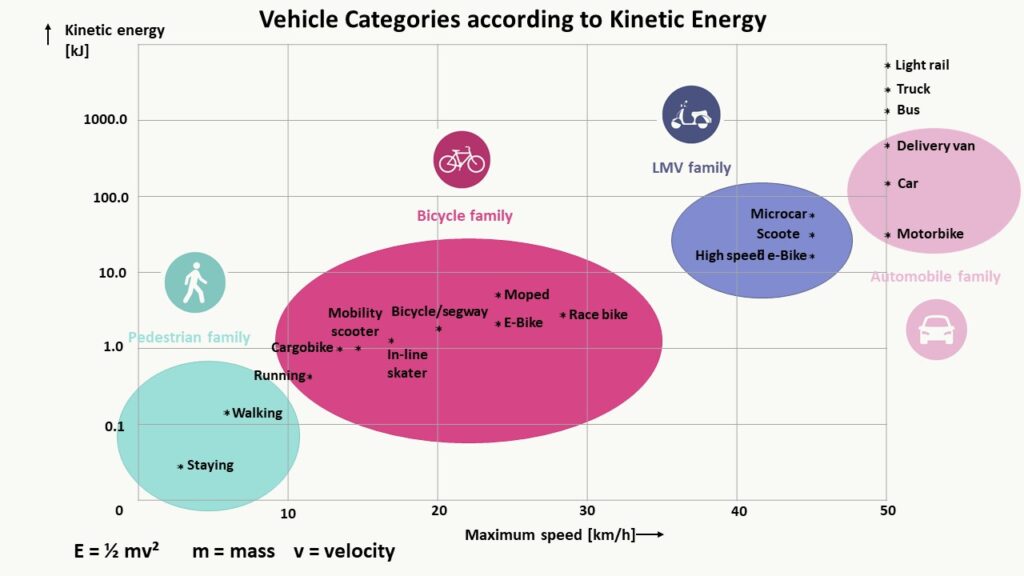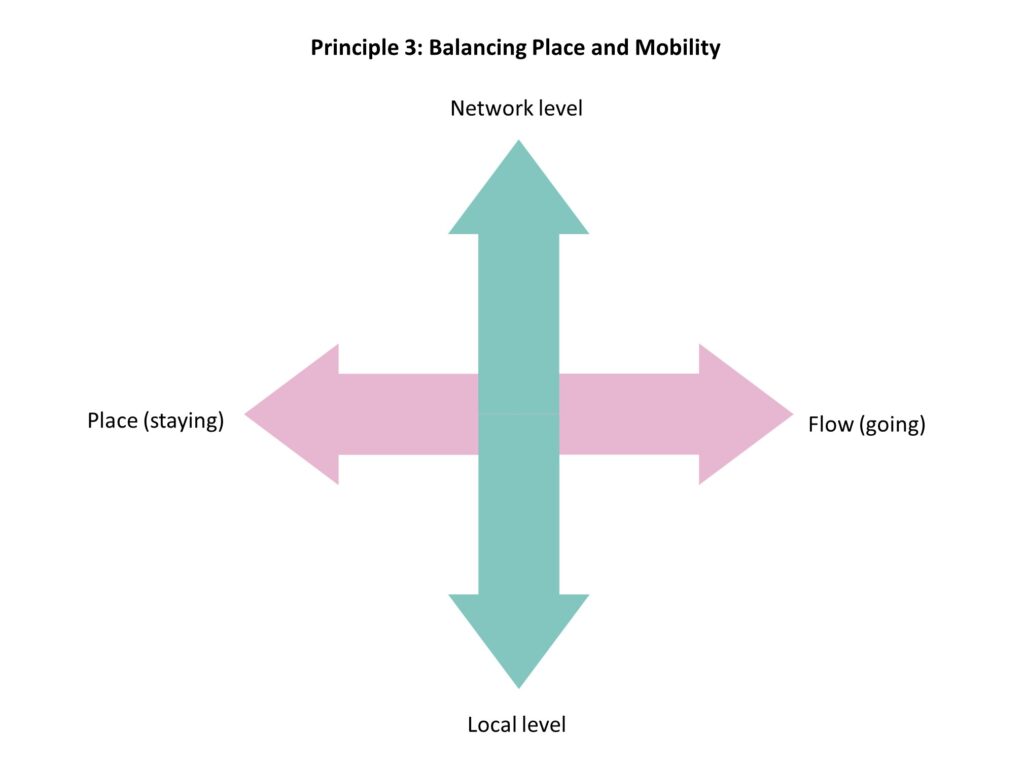The Good Street: A New Framework for Sustainable Mobility and Urban Design

Share this Post
As cities continue to grow in popularity and size, an inevitable tension between two key urban features has emerged: place (quality of access to shops and services) and flow (movement of people and goods from A to B). The challenge lies in finding a balance between these two factors, as dedicating more space to high-quality public spaces often reduces the efficiency of movement through the city, while prioritizing efficient flows through the city makes it difficult to create attractive public spaces. To address this issue, Mobycon, together with partners from the Netherlands, has developed “The Good Street,” a city planning approach that seeks to strike a balance between place and flow within the urban environment. This approach offers a fresh perspective on public space design, resulting in streets that are safe, comfortable, and enjoyable for all users.
From Car-Centric to People-Centric: Addressing the Challenges of Urban Growth
In the twentieth century, car-centric planning led to much of the public space in cities being dedicated to the movement and storage of cars. The twenty-first century has brought urban growth at an unprecedented rate: by 2050 there will be an additional 2.5 billion people living in cities, putting even more pressure on limited public space. This increase in city dwellers cannot be solved by traditional planning methods. Additionally, there are new challenges that are affecting cities such as increased diversity of vehicles (mainly micro-mobility), increased traffic fatalities and serious injuries, and an urgent climate crisis, that mandates a transition to sustainable and active mobility. To meet this growing demand and the changing needs of cities in the 21st century, there is an urgent need to reevaluate urban design strategies.
In 2016, in response to the new challenges in urban planning and traffic safety, the ANWB (Dutch Royal Touring Club), developed a design methodology called “Verkeer in de Stad” (Traffic in the City). This approach was further developed in collaboration with Mobycon and other Dutch partners, resulting in The Good Street: A New Approach for Rebalancing Place and Mobility. “The Good Street” is a systematic approach that examines the desired goals for spatial quality and traffic networks, and devises guiding principles to achieve them.
The Good Street Approach
When applying The Good Street approach, it is essential to consider four key characteristics to guide the design of the urban public space:
Safety and Forgiving Design: The design should minimize collisions and ensure a forgiving environment for all users, such as well-designed shoulders that prevent cars from veering out of their lanes. This principle aligns with the concept of Sustainable Safety.
Livability: The design should enhance the quality of life, work, and place for all users by creating a pleasant and comfortable environment.
In addition to these guiding characteristics, The Good Street approach incorporates seven principles that inform the design decisions:
Principle 1: Balancing Speed Limit and Public Space Design
The design of a typical modern urban street can create unsafe conditions due to the differences in speed and size of vehicles sharing the same public space (e.g. cars and bicycles). The Good Street approach aims to create a safer and calmer environment by imposing a single speed limit for all vehicles, and designing the public space accordingly. This involves incorporating various traffic calming techniques, such as street narrowing, raised crosswalks and intersections, and segregated or raised cycle lanes, to regulate vehicle speed and separate different modes of transportation.
Principle 2: Vehicle “Families” – The classification of vehicles (first) by mass and (second) by attainable speed
The Good Street approach classifies vehicles into different categories based on their kinetic energy. This is determined by considering both the mass and speed of the vehicle. The following image shows the vehicle families: Pedestrians, Bicycles (including E-Bicycles, Cargo-bicycles, race bikes, and mopeds), LMVs (Light Motorized Vehicles such as scooters, high-speed e-bicycles, and microcars), and Automobiles (including cars, motorbikes, and delivery vans). However, trucks, buses, and light rail are not included in these families as they have much greater velocity and mass, and are considered separately in Good Street planning.

Figure 2 : Adapted from “Different Vehicle Categories” (Mobycon, 2020)
Principle 3: Balancing Place and Mobility
In urban areas, people occupy the public space by either staying in one place or by moving from one place to another. The Good Street approach recognizes this duality and emphasizes the importance of balancing the needs of both “place” and “flow.” This means finding the right balance between the overall network of streets and individual local streets, and ensuring that the design of public space meets the needs of both stationary activities and mobility. By prioritizing pedestrians, bicycles, and public transit, The Good Street approach aims to create public space that is safe, accessible, and livable for all users.

Figure 3: Adapted from “The Good Street– Principle 3” (Mobycon, 2020)
Principle 4: Start with the quality of public space
The flow of traffic plays an important role in the life of a city and is often the first priority within urban planning. While getting people and goods from A to B within a city is important, the quality of public space in A and B is often neglected. Is street A a place that you would like to sit and enjoy a coffee at? Or is it just a street A to drive through to get to street B quickly. In The Good Street approach, the spatial quality of A and B are assessed, and a balance with the flow is found.
Principle 4: Prioritizing the Quality of Public Space
In urban planning, traffic flow is often given priority, but The Good Street approach emphasizes the importance of the quality of public space. While it is crucial to move people and goods efficiently, it is equally important to consider whether the public space is inviting and enjoyable. Does street A have characteristics that encourage people to stop and spend time there, or is it just a thoroughfare to get to street B as quickly as possible? The Good Street approach assesses the spatial quality of streets A and B, and strives to strike a balance between the flow of traffic and the overall quality of the public space.
Principle 5: Separating Traffic Networks for Each Vehicle Category
As the volume and variety of vehicles on urban streets continue to increase, it is crucial to develop separate traffic networks for each vehicle category. This ensures safe and efficient movement from point A to point B for all types of rides, whether it be pedestrians, bicycles, light motorized vehicles (LMVs), or automobiles. By providing dedicated space and infrastructure for each category, The Good Street approach prioritizes the safety and convenience of all road users.
Principle 6: Network level: Defining urban traffic environments by combining networks and desired spatial qualities
At the network level, which includes the streets within a city, it is crucial to assess which vehicle family should be dominant and what speed limit should be applied to ensure safety and balance between flow and place. This assessment will define the urban traffic environment and should take into consideration the desired spatial qualities, such as the quality of public space, walkability, and accessibility.
Principle 7: Local Level: Dividing the urban traffic environment into domains
To achieve the desired balance between place and flow at the local level, The Good Street approach investigates the ideal layout of the public space. The public space is divided into one or more domains, each with a maximum speed limit and a corresponding vehicle family, to create a coherent and safe environment. The aim is to minimize differences in mass and speed within each domain, ensuring that all users can move safely and comfortably.
Implementing The Good Street Approach in Cities and Communities
The Good Street approach has been successfully implemented in multiple cities and communities by Mobycon to provide strategic and creative solutions for street design. Recently, the City of Nanaimo in Canada worked with Mobycon to improve the public realm of Commercial Street, a major street in the city center. An Integrated Place Assessment survey was conducted to understand how the street was being used and how the community envisioned it in the future. Using the design principles of The Good Street, new designs were developed that balanced both place and flow on Commercial Street.
No One-Size-Fits-All Solution
It’s essential to note that The Good Street approach is not a one-size-fits-all solution but a flexible guideline that ought to be tailored to various urban environments and contexts. Each city and public space has unique challenges and opportunities, and the approach is meant to provide designers, engineers, and policymakers with the tools to find a better balance between place and flow in their specific context.
To learn more about The Good Street approach, check out the guide and webinar series, which cover topics such as the history of balancing place and mobility, balancing place and flow, and putting the approach into action:
- The Good Street Part 1: From Past to Present: The History of Balancing Place and Mobility
- The Good Street Part 2: Balancing Place and Flow
- The Good Street Part 3: Putting the Approach into Action
The opinions expressed in this text are solely that of the author/s and do not necessarily reflect the views of the Israel Public Policy Institute (IPPI) and/or its partners.
Share this Post

Transitioning to a Circular Economy: What are the Challenges?
The expected increase in world population to 9.7 billion world citizens in 2050, alongside a growing middle-class, is leading to…

Battling Misinformation with Science
Authors: Markus Weisskopf and Rebecca Winkels Lessons from Promoting Science Communication to Fight Misinformation in Germany The COVID-19…

The Case for an Emergency Regime for Cyberspace
It’s a scenario that’s been on the very top of every cybersecurity official’s list of nightmares for a…
